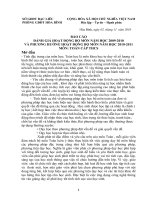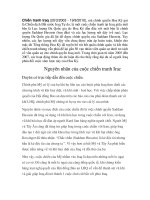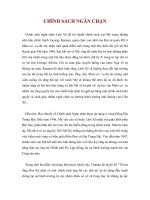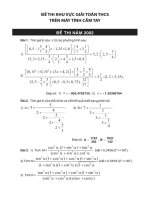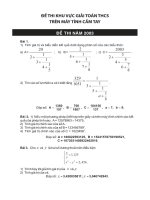patterns and figures grade 8 Bộ Sách Toán THCS Của Mỹ
Bạn đang xem bản rút gọn của tài liệu. Xem và tải ngay bản đầy đủ của tài liệu tại đây (2.5 MB, 55 trang )
Patterns
and Figures
Algebra
CuuDuongThanCong.com
/>
Mathematics in Context is a comprehensive curriculum for the middle grades.
It was developed in 1991 through 1997 in collaboration with the Wisconsin Center
for Education Research, School of Education, University of Wisconsin-Madison and
the Freudenthal Institute at the University of Utrecht, The Netherlands, with the
support of the National Science Foundation Grant No. 9054928.
The revision of the curriculum was carried out in 2003 through 2005, with the
support of the National Science Foundation Grant No. ESI 0137414.
National Science Foundation
Opinions expressed are those of the authors
and not necessarily those of the Foundation.
Kindt, M., Roodhardt, A., Wijers, M., Dekker, T., Spence, M. S., Simon, A. N.,
Pligge, M. A., and Burrill, G. (2006). Patterns and figures. In Wisconsin Center for
Education Research & Freudenthal Institute (Eds.), Mathematics in Context.
Chicago: Encyclopædia Britannica, Inc.
Copyright © 2006 Encyclopædia Britannica, Inc.
All rights reserved.
Printed in the United States of America.
This work is protected under current U.S. copyright laws, and the performance,
display, and other applicable uses of it are governed by those laws. Any uses not
in conformity with the U.S. copyright statute are prohibited without our express
written permission, including but not limited to duplication, adaptation, and
transmission by television or other devices or processes. For more information
regarding a license, write Encyclopædia Britannica, Inc., 331 North LaSalle Street,
Chicago, Illinois 60610.
ISBN 0-03-038696-9
2 3 4 5 6 073 09 08 07 06
CuuDuongThanCong.com
/>
The Mathematics in Context Development Team
Development 1991–1997
The initial version of Patterns and Figures was developed by Martin Kindt and
Anton Roodhardt. It was adapted for use in American schools by Mary S. Spence,
Aaron N. Simon, and Margaret A. Pligge.
Wisconsin Center for Education
Freudenthal Institute Staff
Research Staff
Thomas A. Romberg
Joan Daniels Pedro
Jan de Lange
Director
Assistant to the Director
Director
Gail Burrill
Margaret R. Meyer
Els Feijs
Martin van Reeuwijk
Coordinator
Coordinator
Coordinator
Coordinator
Sherian Foster
James A, Middleton
Jasmina Milinkovic
Margaret A. Pligge
Mary C. Shafer
Julia A. Shew
Aaron N. Simon
Marvin Smith
Stephanie Z. Smith
Mary S. Spence
Mieke Abels
Nina Boswinkel
Frans van Galen
Koeno Gravemeijer
Marja van den
Heuvel-Panhuizen
Jan Auke de Jong
Vincent Jonker
Ronald Keijzer
Martin Kindt
Jansie Niehaus
Nanda Querelle
Anton Roodhardt
Leen Streefland
Adri Treffers
Monica Wijers
Astrid de Wild
Project Staff
Jonathan Brendefur
Laura Brinker
James Browne
Jack Burrill
Rose Byrd
Peter Christiansen
Barbara Clarke
Doug Clarke
Beth R. Cole
Fae Dremock
Mary Ann Fix
Revision 2003–2005
The revised version of Patterns and Figures was developed by Monica Wijers and
Truus Dekker. It was adapted for use in American schools by Gail Burrill.
Wisconsin Center for Education
Freudenthal Institute Staff
Research Staff
Thomas A. Romberg
David C. Webb
Jan de Lange
Truus Dekker
Director
Coordinator
Director
Coordinator
Gail Burrill
Margaret A. Pligge
Mieke Abels
Monica Wijers
Editorial Coordinator
Editorial Coordinator
Content Coordinator
Content Coordinator
Margaret R. Meyer
Anne Park
Bryna Rappaport
Kathleen A. Steele
Ana C. Stephens
Candace Ulmer
Jill Vettrus
Arthur Bakker
Peter Boon
Els Feijs
Dédé de Haan
Martin Kindt
Nathalie Kuijpers
Huub Nilwik
Sonia Palha
Nanda Querelle
Martin van Reeuwijk
Project Staff
Sarah Ailts
Beth R. Cole
Erin Hazlett
Teri Hedges
Karen Hoiberg
Carrie Johnson
Jean Krusi
Elaine McGrath
CuuDuongThanCong.com
/>
(c) 2006 Encyclopædia Britannica, Inc. Mathematics in Context
and the Mathematics in Context Logo are registered trademarks
of Encyclopædia Britannica, Inc.
Cover photo credits: (all) © Corbis
Illustrations
7 Holly Cooper-Olds; 12 Steve Kapusta/© Encyclopædia Britannica, Inc.;
15, 17 James Alexander; 29 Holly Cooper-Olds; 34 James Alexander
Photographs
1 (left to right) © Pixtal; Brand X Pictures/Alamy; © Corbis; 6 PhotoDisc/
Getty Images; 20 Alvaro Ortiz/HRW Photo; 24 Victoria Smith/HRW;
35 BananaStock/Alamy
CuuDuongThanCong.com
/>
Contents
Letter to the Student
Section A
Patterns
Number Strips
V- and W-Formations
Summary
Check Your Work
Section B
10
12
15
17
18
18
Square Numbers
Looking at Squares
Area Drawings
Shifted Strips
Summary
Check Your Work
Section D
1
5
8
8
Sequences
Constant Increase/Decrease
Adding and Subtracting Strips
Pyramids
Prisms
Summary
Check Your Work
Section C
vi
20
22
23
26
27
Triangles and Triangular
Numbers
Tessellations and Tiles
Triangular Patterns
Triangular Numbers
Rectangular Numbers
A Wall of Cans
The Ping-Pong Competition
Summary
Check Your Work
28
30
32
33
34
35
36
36
Additional Practice
39
Answers to Check Your Work
44
Contents v
CuuDuongThanCong.com
/>
Dear Student,
Welcome to the unit Patterns and Figures. In this unit, you will identify
patterns in numbers and shapes and describe those patterns using
words, diagrams, and formulas.
You have already seen many patterns in mathematics. For patterns
with certain characteristics, you will learn rules and formulas to help
you describe them. Some of the patterns are described by using
geometric figures, and others are described by a mathematical
relationship.
Here are two patterns. One is a pattern of dots, and the other is a
pattern of geometric shapes.
Can you describe the dot pattern? Where do you think the pattern
of shapes ends?
As you investigate the Patterns and Figures unit, remember that
patterns exist in many places—almost anywhere you look! The skills
you develop in looking for and describing patterns will always help
you, both inside and outside your math classroom.
Sincerely,
The Mathematics in Context Development Team
vi Patterns and Figures
CuuDuongThanCong.com
/>
A
Patterns
Number Strips
Patterns are at the heart of mathematics, and you can find patterns by
looking at shapes, numbers, and many other things. In this unit, you
will discover and explore patterns and describe them with numbers
and formulas.
Below, numbers starting with 0 are shown on a paper strip. The strip
has alternating red and white colors.
1. Notice that the right end of the strip looks different from the left
end. What do you think that indicates?
0
1
2
3
4
5
6
7
8
9
10
2. a. What do the white numbers have in common?
b. Think of a large number not shown on the strip. How can you
tell the color for your number?
Section A: Patterns 1
CuuDuongThanCong.com
/>
A Patterns
Here is a different strip made with the repeating pattern red – white –
blue — red — white — blue.
Red
0
White
1
Blue
2
Any list of numbers that goes on forever is called a sequence.
3. How can you figure out the color in the red-white-blue sequence
for 253,679?
One way to “see” a pattern is to use dots to represent numbers. For
example, the red numbers from the red and white strip on page 1 can
be drawn like this:
Dot Pattern:
Pattern Number: 0
1
2
3
4
5
Below each dot pattern is a pattern number. The pattern number tells
you where you are in a sequence. (Notice that the pattern number
starts with 0, and there are no dots for pattern number 0.)
Pattern number 1 shows two dots, pattern number 2 shows four dots,
and so on, assuming that the pattern continues building dots in the
same way.
4. a. Look at the dot pattern for the red numbers. When the pattern
number is 37, how many dots are there?
b. Someone came up with the formula R ؍2n for the red
numbers. What do you think R and n stand for?
c. Does the formula work? Explain your answer.
2 Patterns and Figures
CuuDuongThanCong.com
/>
Patterns A
You can represent the white numbers from the red-white strip on
page 1 in their own pattern: 1, 3, 5, …
These numbers can be represented using a different dot pattern as
shown below.
Dot Pattern:
Pattern Number:
0
1
2
3
4
5
5. a. Now look at the pattern for the white numbers. How many
dots are in pattern number 50?
b. Write a formula for the white numbers.
Rule: “If you add two odd numbers, you get an even number.”
6. a. Use dots to explain the rule above.
b. Make up some other rules like the one above, and use dots to
explain them.
The sequence of even numbers {0, 2, 4, 6, 8 …} can be described by
the formula:
START number
؍0
NEXT even number ؍CURRENT even number ؉ 2
You may have seen these “NEXT-CURRENT” formulas in previous
Mathematics in Context units. They are more formally called
recursive formulas.
7. a. Write a NEXT-CURRENT formula for the sequence of odd
numbers
{1, 3, 5, 7}.
b. Compare the formulas for even and odd numbers assuming
that the pattern continues building dots in the same way. What
is the same and what is different?
A formula such as those you found above for even and odd numbers
is called a direct formula.
8. Why do you think these are called direct formulas?
Section A: Patterns 3
CuuDuongThanCong.com
/>
A Patterns
Look again at the red–white–blue sequence from page 2.
Red
0
White
1
Blue
2
9. a. Represent the red, white, and blue numbers using dot patterns
similar to the dot patterns shown on pages 2 and 3.
b. Write a NEXT-CURRENT formula and a direct formula for the
sequence of red numbers. State where your sequence begins
in both cases.
c. Do the same for the sequences of white numbers and blue
numbers.
d. If you add a white number to a blue number, do you always
get a red number? Use dots to explain your answer.
e. Copy the chart in your notebook and complete it for all
combinations of colors.
؉
R
W
B
R
W
B
4 Patterns and Figures
CuuDuongThanCong.com
/>
Patterns A
V- and W-Formations
Have you ever seen birds
fly in a V-formation?
You can make a sequence of V-patterns using dots. The first four are
shown below.
1
4
3
2
Here is a V-number that uses 17 dots.
?
Section A: Patterns 5
CuuDuongThanCong.com
/>
A Patterns
?
10. a. What is the pattern number of this drawing?
b. How many dots are in pattern number 85?
c. Is it possible to make a V-pattern with 35,778 dots? Explain
why or why not.
d. Write a direct formula to describe the number of dots in any
V-pattern. V ? ؍
The letter n is usually used in direct formulas to denote pattern
numbers.
For some patterns n starts with 0 and sometimes with 1. It may start
with other numbers as well.
11. If you haven’t already done so, write your V-pattern formula using
the letter n.
Squadrons of airplanes sometimes fly in a W-formation.
6 Patterns and Figures
CuuDuongThanCong.com
/>
Patterns A
Look at the following sequence of W-patterns.
2
1
3
12. a. Copy and complete this chart for the W-patterns.
Number of Dots
5
Pattern Number
1
2
3
4
5
6
b. Write a NEXT-CURRENT formula for the number of dots in the
W-pattern sequence.
c. How many dots are in pattern number 16?
d. Find a direct formula to describe the number of dots in any
W-pattern. Then use your formula to find the number of dots
in pattern number 25.
Jessie compared the W-patterns to the V-patterns. She said, “W is
double V minus one.”
13. a. What did Jessie mean? Use dot patterns to explain her
statement.
b. Explain Jessie’s statement using direct formulas for W … ؍and
V…؍
The Williams Pie Company
wants to display a big “W”
with orange light bulbs on
a billboard. They order
200 light bulbs.
14. If they place the light
bulbs in a W-pattern, how
many bulbs would there
be in the largest W they
can make?
Section A: Patterns 7
CuuDuongThanCong.com
/>
A Patterns
Number strips and dot patterns can illustrate sequences of numbers.
You can use formulas to describe sequences and to find numbers
later in the sequence. Here is an example where the dots continue to
build in the same way.
Dot Pattern:
Pattern Number:
0
1
2
3
A NEXT-CURRENT formula or recursive formula has two parts: a start
value and a rule for finding each “next” value. A recursive formula for
the number of dots in the dot pattern above is:
START number ؍1
NEXT number ؍CURRENT number ؉ 3
A direct formula uses n to indicate the pattern number. If D stands for
the number of dots, a direct formula for the pattern above is:
D ؍3n ؉ 1, where n starts with 0.
1. James wrote the direct formula D ؍1 ؉ n ؉ n ؉ n for the dot
pattern in the Summary. Show whether or not James’s formula
is correct.
8 Patterns and Figures
CuuDuongThanCong.com
/>
Look again at the dot pattern of page 3.
Dot Pattern:
Pattern Number:
0
1
2
3
4
5
David came up with the formula W ؍2n ؉ 1 for this pattern.
Cindy found the direct formula W ؍2(n ؉ 1) ؊ 1
2. a. Are both formulas correct? Why or why not?
b. How would David’s formula change if the first pattern number
is 1 instead of 0?
3. a. Make a sequence of dot patterns for the direct formula
D ؍5n ؉ 2, where n starts at 0.
b. Write a NEXT-CURRENT formula for the sequence.
4. a. Make up your own dot-pattern sequence.
b. Write a direct formula and a NEXT-CURRENT formula for your
sequence.
5. Reflect What is one advantage and one disadvantage of a recursive formula compared to a direct formula?
Can every sequence of numbers be represented by a dot pattern?
Why or why not?
Section A: Patterns 9
CuuDuongThanCong.com
/>
B
Sequences
Constant Increase/Decrease
A sequence that has a constant increase or decrease is called an
arithmetic sequence. Here is an example of an arithmetic sequence.
The jagged right end indicates that the strip continues forever.
2
9
؉7
16
؉7
23
؉7
؉7
1. a. Write four more numbers as they appear on the strip.
b. Will the number 100 be on the number strip? How do you know?
c. How about the number 200?
d. Write a large number that will never appear on the strip. How
do you know for sure that it will never appear?
Jorge came up with the expression 2 ؉ 7n for the number strip shown
on this page.
2. a. Where does n start in Jorge’s expression?
b. Use the expression to find the next three numbers on the strip.
Here is a number strip showing a different arithmetic sequence.
41
65
3. a. Find the missing numbers on the strip.
b. Write a recursive formula for this number strip.
c. Write an expression for this number strip. Let n start at zero.
10 Patterns and Figures
CuuDuongThanCong.com
/>
Sequences B
Instead of adding a number at each step, some arithmetic sequences
subtract a number at each step.
85
83
81
79
77
75
4. a. What is the decrease in this sequence?
b. Write an expression for this number strip. Let n start at 0.
c. Explain the difference between a (direct) formula and an
expression.
d. How many steps does it take to get to the first negative
number in this strip?
5. Find an expression for the arithmetic sequence in the number
strip drawn below. Let n start at 0 in your expression. You may
copy the strip in your notebook and fill in the missing numbers
first if you want to.
3
3–
4
1
3–
2
3
1
2–
2
1
2–
4
6. Write the first five numbers in each of the sequences described
by the following expressions. For each sequence, n starts at zero.
a. 4 ؊ 3n
1 ؉ ᎑᎑
1n
b. 2 ᎑᎑
2
2
c. 5n ؊ 10
d. 12n
Many sequences are not arithmetic. Some involve multiplication and
division.
7. a. Design a sequence that has a pattern or regularity but is not an
arithmetic sequence.
b. Describe the regularity in your sequence.
Section B: Sequences 11
CuuDuongThanCong.com
/>
B Sequences
Adding and Subtracting Strips
Larry’s favorite number strip is the sequence of odd numbers. He
decides to add his number strip of odd numbers to the strip of even
numbers.
Even
0
2
4
6
8
10
1
2
14
16
18
20
22
Odd
1
3
5
7
9
11
1
3
15
17
19
21
23
Here are the first three numbers of the resulting sequence:
Even and Odd
11
5
9
8. Copy the number strip above and find the next nine numbers in
the new sequence.
There is a connection between the W-patterns shown and the new
number strip.
9. What is that connection?
12 Patterns and Figures
CuuDuongThanCong.com
/>
Sequences B
10. a. Write an expression for each of the three numbers strips in
problem 8. Let n start at zero.
b. How can you use your expressions to check that the third
sequence is the sum of the other two?
Compare these three number strips:
A
12
17
؉5
B
8
20
؉5
10
؉2
A؉B
22
27
؉5
12
؉2
32
؉5
14
؉2
37
؉5
16
؉2
42
؉5
18
؉2
47
؉5
20
؉2
22
؉2
27
Number strips A and B are arithmetic sequences. The entries in the
third strip, A ؉ B, are formed by adding the numbers that appear in
the same positions on strips A and B.
11. a. Without filling in the numbers for the strip A ؉ B, you can
show that it must be an arithmetic sequence. Explain how.
b. Write expressions for the number strips A, B, and A ؉ B.
c. Make a number strip for A ؊ B. Do the numbers form an
arithmetic sequence? Explain why or why not.
d. What expression corresponds to the number strip A ؊ B?
Section B: Sequences 13
CuuDuongThanCong.com
/>
B Sequences
Strips C and D are two other number strips. The expression for
strip C is 6 ؉ 3n, and the expression for strip D is 4 ؉ 5n. For both
strips, n starts at zero.
Jim wants to make an expression for the strip C ؉ D. First he makes
the strips C and D. Then he adds the numbers on the two strips to get
the numbers on strip C ؉ D.
Then he makes the expression for the strip C ؉ D.
12. Show the three steps in Jim’s solution.
Gail thinks she knows a shorter way to come up with the expression.
13. a. What might Gail have in mind?
b. What is the expression for the number strip C ؊ D?
14. Copy the three strips into your notebook. Fill in the missing
numbers and write the expression for each number sequence.
4
9
14
19
24
29
1
3
5
؉
9
؍
11
34
4 ؉ 5n
7
13
؉
؍
14 Patterns and Figures
CuuDuongThanCong.com
/>
Sequences B
15. Copy the three strips shown below. Fill in the missing numbers
and write an expression for each number sequence.
5
6
11
10
17
14
؊
23
29
35
؍
18
22
26
؊
؍
16. a. Write an expression for the sum of 17 ؉ 5n and 13 ؊ 7n.
b. Write an expression for the difference of 17 ؉ 5n and 13 ؊ 7n.
Use number strips to show why your answer makes sense.
Pyramids
Billy is a glass artist who makes geometric shapes out of glass. Here
is a sequence of his pyramids.
3
4
5
6
17. Explain the numbers below the pyramids.
Section B: Sequences 15
CuuDuongThanCong.com
/>
B Sequences
This number strip represents the number of vertices (V ) for the
sequence of pyramids. A vertex is the intersection of the edges of the
pyramid.
V
4
5
6
7
3
4
5
6
8
7
18. Find a formula for number strip V that relates V (the number of
vertices) to n (the numbers below the pyramids). Where does
n start?
19. a. Make number strips for the numbers of edges (E ) and the
numbers of faces (F ) for the sequence of pyramids.
b. Write formulas for number strips E and F.
c. Combine number strips V, E, and F into a new number strip
whose formula shows V ؊ E ؉ F.
V
E
F
?
?
?
?
?
?
3
4
5
6
7
8
d. What’s special about the number strip in part c? Explain this
special property using the expressions for V, E, and F.
16 Patterns and Figures
CuuDuongThanCong.com
/>
Sequences B
Prisms
3
4
5
6
20. a. Make number strips V, E, and F for the sequence of prisms
shown above.
b. Write expressions for number strips V, E, and F (expressed in
terms of n).
c. Use the number strips or the expressions to check that
V ؊ E ؉ F ؍2 for prisms.
The formula V ؊ E ؉ F ؍2 is called Euler’s formula (Euler is pronounced
“Oiler”). You have seen this formula in the Packages and Polygons unit.
The formula works for many polyhedra. For example, an icosahedron
has 20 faces. For any icosahedron, V ؍12, E ؍30, and F ؍20. Using
these values gives 12 –30 ؉ 20 ؍2.
Section B: Sequences 17
CuuDuongThanCong.com
/>
B Sequences
A sequence is called arithmetic if it has a constant increase or
decrease at each step.
70
95
؉25
120
؉25
145
؉25
170
؉25
؉25
At n steps from the starting number 70, you get the number 70 ؉ 25n.
This expression represents the sequence. Note that n starts at zero.
You can combine number sequences by adding or subtracting them.
Adding or subtracting number sequences can be done using number
strips or expressions.
For any polyhedron, Euler’s formula V ؊ E ؉ F ؍2 gives a
relationship between the numbers of vertices, edges, and faces.
Many other sequences are not arithmetic, for instance the sequence
formed by multiplying each term by 1᎑᎑
2:
1, 1
1, 1᎑᎑
2 , ᎑᎑
4 ᎑᎑
8.
A recursive formula for this sequence is NEXT = CURRENT ؋ 1᎑᎑
2
Belinda and Carmen are saving money from part-time jobs after school.
1. a. Belinda currently has $75. She decides to add $5 to her
savings each week. Make a number strip that begins with 75
and shows Belinda’s total savings every week. What are her
savings after n weeks?
b. Carmen currently has $125. Every week she adds twice as
much as Belinda does. What are her savings after n weeks?
18 Patterns and Figures
CuuDuongThanCong.com
/>
Look again at the sequence.
70
95
؉25
120
؉25
145
؉25
170
؉25
؉25
2. a. What is the 15th number in this sequence?
b. When does the value exceed 1,000 for the first time?
3. a. Make your own arithmetic sequence using fractions.
b. Write an expression that represents your sequence.
4. Reflect If you add two arithmetic sequences, do you always get
an arithmetic sequence? Explain why or why not.
A five-sided tower is made by putting a five-sided pyramid on top of a
five-sided prism, as shown below.
For this tower:
V ؍11
E ؍20
F ؍11
5. a. Does Euler’s formula work for a five-sided tower? Explain your
answer.
b. Check to see whether Euler’s formula works for an n-sided
tower.
Can you find a solid for which Euler’s formula does not work? If you
can, give an example.
Section B: Sequences 19
CuuDuongThanCong.com
/>


